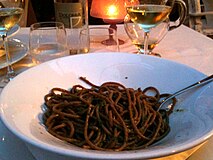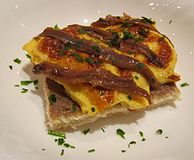
Anchovy paste is a fish paste food product prepared using anchovies as a primary ingredient.[1] It is used as a condiment and as an ingredient in various dishes, such as Scotch woodcock, and is a mass-produced product. It has been used for centuries to provide flavor to foods and as a source of nutrients, and it is a part of the cuisines of Great Britain, Italy, the Philippines and Vietnam. It is a major export product of Morocco.
Overview[edit]
Anchovy is used as a condiment and as an ingredient in various dishes.[1][2] Basic ingredients in its preparation includes mashed anchovies, vinegar, spices and water, and some commercial preparations are produced using these ingredients.[3] Butter is also sometimes used as a base ingredient, and the resultant product is sometimes referred to as "anchovy butter", and in French as beurre d'anchois.[1][4][5][6]
History[edit]
Anchovy paste has been used for centuries as a source of nutrients and to provide flavour to foods.[6][7] Allec, a food byproduct used as a condiment that dates to the times of classical antiquity and Ancient Rome, is the paste left over from the preparation of liquamen (a predecessor to garum prepared using various oily fish, including anchovies) that has been described as a "precursor to anchovy paste".[8][9][10][11][12] Anchovy paste has also been described as a "descendant of garum".[13]
Mass production[edit]
Anchovy paste is a mass-produced product, and is sometimes produced using leftover anchovies from anchovy packing facilities that are processed, mixed with additional ingredients, and packaged into tubes.[2] Circa the early 1900s, food colouring was sometimes used in commercial preparations of the paste.[14] Today, anchovy paste is a major export product of Morocco.[13]
Notable brands[edit]
Gentleman's Relish is a brand of mass-produced spiced anchovy paste that was introduced in England in 1828.[15][16]
Use in dishes[edit]
Some uses of anchovy paste include its use as a condiment or ingredient in egg dishes and on toast.[17] It can be used as an ingredient in some hors d'oeuvre.[1] Anchovy paste is a common food in Italy, where it is used served atop canapés and vegetables and as an ingredient in sauces and pasta dishes.[18] It is also a part of the cuisine of the Philippines, where it is referred to as bagoong balayan, and of Vietnam, where it is referred to as mam nem.[19][20][21] Anchovy paste can be used as an ingredient in the preparation of anchovy sauce.[22]
Scotch woodcock is a British savoury dish prepared using scrambled eggs atop toast that has been spread with anchovy paste or Gentleman's Relish.[1][23][24][25] Whole anchovies are also sometimes used in the dish.[26]
-
Bigoli in salsa (bigoli with anchovy sauce) at a restaurant in Venice, Italy
-
Scotch woodcock garnished with anchovy fillets and parsley. The anchovy paste is beneath the anchovy fillets.
See also[edit]
- Anchovies as food – Preserved fish
- Anchovy essence – Thick, oily sauce of pounded anchovies and spices
- Fish sauce – Condiment made from fish
- List of condiments
- Myeolchi-jeot – Korean salted and fermented anchovies
- Bagoong monamon – Philippine food ingredient made by fermenting salted anchovies
- Relish – Cooked, pickled, or chopped vegetable or fruit used as a condiment
- Shrimp paste – Fermented condiment
References[edit]
- ^ a b c d e The Housekeeper's Guide to Preserved Meats, Fruits, Vegetables, &c. Crosse & Blackwell. 1886. pp. 4–5. Retrieved May 7, 2017.
- ^ a b Joachim, D. (2001). The Clever Cook's Kitchen Handbook. Rodale. pp. 3–4. ISBN 978-1-57954-549-9.
- ^ Herbst, S.T. (2010). The New Food Lover's Tiptionary. Harper Collins. p. 6. ISBN 978-0-06-201167-1. Retrieved May 7, 2017.
- ^ Multilingual Dictionary of Fish and Fish Products. Wiley. 2009. p. 6. ISBN 978-1-4443-1942-2. Retrieved May 7, 2017.
- ^ White, William (1904). Notes & Queries. Oxford University Press. p. 72.
- ^ a b Viard, A. (1812). Le Cuisinier Impérial, ou l'art de faire la cuisine et la pâtisserie pour toutes les fortunes ... Septième édition ... augmentée, etc (in French). p. 48. Retrieved May 7, 2017.
- ^ Maderia, C.J.; Spilka, J.K. (2007). The New Seaweed Cookbook: A Complete Guide to Discovering the Deep Flavors of the Sea. Cookery, Food and Drink Series. North Atlantic Books. p. 85. ISBN 978-1-55643-652-9.
- ^ Hosking, R. (2006). Authenticity in the Kitchen: Proceedings of the Oxford Symposium on Food and Cookery 2005. Proceedings of the Oxford symposium on food and cookery. Prospect books. p. pt206–207. ISBN 978-1-903018-47-7. Retrieved May 7, 2017.
- ^ Weiss, J.; Andrés, J.; Rawlinson, N.; Mora, S. (2014). Charcutería: The Soul of Spain. Agate Publishing. p. 171. ISBN 978-1-57284-737-8.
- ^ Baudar, P. (2016). The New Wildcrafted Cuisine: Exploring the Exotic Gastronomy of Local Terroir. Chelsea Green Publishing. p. 49. ISBN 978-1-60358-606-1.
- ^ Dalby, A. (2013). Food in the Ancient World from A to Z. The Ancient World from A to Z. Taylor & Francis. p. 5. ISBN 978-1-135-95422-2.
- ^ Riley, G. (2007). The Oxford Companion to Italian Food. Oxford Companion To... Oxford University Press, USA. p. pt574. ISBN 978-0-19-860617-8.
- ^ a b Roller, D.W. (2004). The World of Juba II and Kleopatra Selene: Royal Scholarship on Rome's African Frontier. Taylor & Francis. p. 115. ISBN 978-1-134-40296-0.
- ^ Home Science Magazine: For Housekeepers and Mothers. Home Science Publishing Company. 1903. p. 123. Retrieved May 7, 2017.
- ^ Slonecker, A.; DeBenedetti, C.; Lee, J.; Asimov, E. (2015). Beer Bites: Tasty Recipes and Perfect Pairings for Brew Lovers. Chronicle Books. p. 112. ISBN 978-1-4521-4059-9.
- ^ van Wyk, B.E. (2014). Culinary Herbs and Spices of the World. University of Chicago Press. p. 36. ISBN 978-0-226-09183-9.
- ^ Boston Cooking School (Boston, Mass.) (1906). American Cookery. p. 257.
- ^ Wright, C. (2003). The Little Foods of the Mediterranean: 500 Fabulous Recipes for Antipasti, Tapas, Hors D'Oeuvre, Meze, and More. Harvard Common Press. p. 26. ISBN 978-1-55832-227-1. Retrieved May 7, 2017.
- ^ Bladholm, L. (2016). The Asian Grocery Store Demystified: A Food Lover's Guide to All the Best Ingredients. St. Martin's Press. p. pt68. ISBN 978-1-250-12695-5. Retrieved May 7, 2017.
- ^ Olizon-Chikiamco, N. (2013). Filipino Favorites. Tuttle Publishing. p. 6. ISBN 978-1-4629-1102-8.
- ^ Garden, New York Botanical; America, Mycological Society of (1986). Mycologia Memoir. Mycologia Memoir. Hafner. p. 337. ISBN 978-3-443-76001-4.
- ^ Fellows, C. (1904). The Culinary Handbook ... Hotel Monthly. p. 2.
- ^ Boxer, A. (2012). Arabella Boxer's Book of English Food: A Rediscovery of British Food From Before the War. Penguin Books Limited. p. pt301. ISBN 978-0-241-96167-4.
- ^ Palmatier, R.A. (2000). Food: A Dictionary of Literal and Nonliteral Terms. ABC-Clio ebook. Greenwood Press. p. 315. ISBN 978-0-313-31436-0.
- ^ Herbst, R.; Herbst, S.T. (2015). The Deluxe Food Lover's Companion, 2nd edition. Barron's Educational Series. pp. pt872–873. ISBN 978-1-4380-7621-8.
- ^ Grimes, L. (2009). The Cook's Book of Everything. Murdoch Books. p. 57. ISBN 978-1-74196-033-4.



